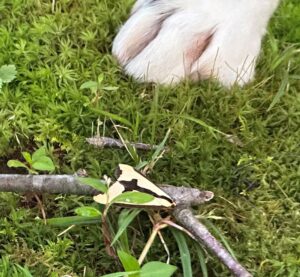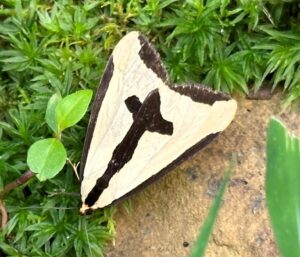Hello fellow readers; I just returned from Lago Vista, Texas, to be by the side of Gene, a dear friend, as he graduated from this earth. He is the life partner of Elsa, whom we’ve spoken about in a previous story titled, Fall is not Goodbye (link below). They’ve been family to me for 40 years; hard to imagine.

Before I left, there was a magical moment.
Before I left, there was a magical moment. A moth landed at my feet while taking Jolee out for the last call before bedtime. Moths are pollinators “that like to party at night.” I’ve grown to admire them as much as butterflies.
This little fellow was new to me; cream-colored with a black marking on his wings in the shape of a cross. I attempted to snag a photo while marveling over the moment. Jolee scared it off—its half-yellow and half-white wings illuminated by the footbridge light. The cross seemed to separate like a puzzle as he flew.
The Clymene Moth is known as the Blessing Moth.
It surprised and delighted me to see him again in the morning before leaving for Texas. He was resting on a stick in a patch of moss below our grand oak as if posing so I could take a better picture. The handy iPhone photos app identified the Clymene moth (Haploa clymene) in the tiger moth subfamily (Arctiinae). Some call it the Blessing Moth because of the beautiful sign of the cross on its folded wings. The name Clymene holds great significance in Greek mythology as a forename for princesses and a water nymph.
The Clymene moth lives in eastern North America from Quebec to Florida and as far west as Kansas and Texas in forests, wetlands, and fields. Butterflies and Moths of North America collects and shares data (ButterfliesandMoths.org) and writes they “may be quite rare in parts of its range, especially at the periphery.” Predators are birds, as you would expect, though poisonous to humans and animals if ingested. Host plants include oaks, willow trees, eupatorium species, peach trees, and other plants. And they enjoy the nectar from flowers. The larvae are blackish-brown caterpillars with a yellow stripe covered in spines.

Clymene moth (Haploa clymene)
Legend of the Blessing Moth
As the legend goes, if you see one, consider it a gift, as you will have a blessing coming forward in your life. And indeed, it was a blessing to make it in time to be with Gene. While he couldn’t speak other than whispering Mary-Mary, Hi Gene-Gene, our customary greeting, he cupped his hands around my face. I asked him if he was afraid, and he nodded no. So, I knew he was ready. It was a precious and sacred moment.
Another blessing was finding a new home for Bella, an unintended rescue that landed in their garage soon after their beloved KC passed, about a year before Elsa. Gene didn’t think adopting the puppy was a good idea based on their health and age. But they kept her because of Elsa, who quickly fell in love.

Lisa and Kobi greet Bella.
The Blessing of Kindness
It was a delight to be part of the meet and greet when Tim and Lisa came to see if Bella was a good fit for their family, complete with Kobi, a boisterous year-and-a-half-old chocolate lab. The angel adopters have been sending photographs and videos of their relationship unfolding and adventures, including Bella’s first boat ride and kisses between them. I’m grateful for their kindness, giving Bella a big life from one mainly spent in the fenced-in yard.

Mary Stone with Gene Martin, who proudly served our country in Vietnam.
Part of life is the ending of life as we know it. But graduating from here is not something to fear. Like the never-ending cycles of nature, everything that composes decomposes—all things return to their source. And we leave behind the love that we gave, perhaps sending signs of that love like the magical moth.
Garden Dilemmas? AskMaryStone@gmail.com and your favorite Podcast App.
There’s more to the story in the Garden Dilemmas Podcast:
Link to the story featuring my friend Elsa – Fall is Not Goodbye
Moth Identification. Com – Clymene Moth (Haploa clymene)



I just stumbled across your site and wanted to learn about your “Blessing Moth” discovery. I am the one who actually coined the term Blessing Moth back in 2002. I believe the Haploa Clymene moth discovers us at just the right time to deliver God’s blessing. I know that was the case in my encounter that you can learn about at https://theblessingmoth.com/. You can have your discovery and photograph certified and registered with the US Geological Survey if you like through the Butterflies and Moths of North America (BAMONA) website. I enjoyed your podcast!
Hello David, Thank you for your kind words about my podcast and for sharing your history about the Blessing Moth. What a beautiful medallion! Coming upon one for the first time the night before the trip to be by Gene’s side will forever stay in my heart — A blessing indeed.
Thank you again for sharing, Mary